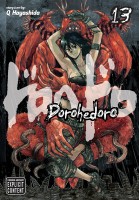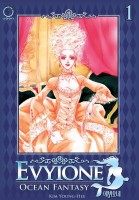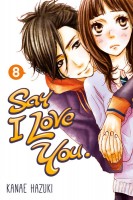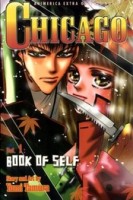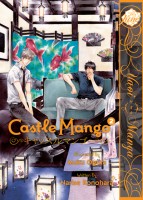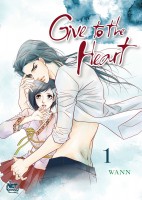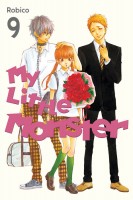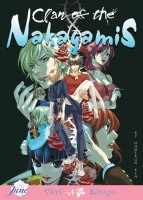My News and Reviews
A few different things posted at Experiments in Manga last week. First up was the announcement of the Yumi Tamura Giveaway Winner which also includes a list of mangaka whose work the giveaway participants consistently enjoy and follow. For the second post last week, which also happens to be the first in-depth review of September, I took a look at Takeshi Matsu’s second English collection of erotic gay manga Dr. Makumakuran and Other Stories which I quite enjoyed. Overall, I think it may even be stronger than his first collection, More and More of You and Other Stories, which I also liked. Finally, over the weekend, I posted August’s Bookshelf Overload for those of you interested in what sorts of things I’ve picked up recently.
A little over a month ago I posted my responses to a game of manga tag. Well, that game is still making the rounds! Most recently, I discovered that Daiyamanga’s Krystallina took the opportunity to talk about her collection. Elsewhere online, Shojo Beat posted a brief interview with Kimi ni Todoke‘s creator Karuho Shiina. And in licensing news, Seven Seas has picked up three more manga: Nanatsuki Takafumi and Risumai’s I Was Abducted by an Elite All-Girls School as a Sample Commoner, Amemiya Yuki and Ichihara Yukino’s Battle Rabbits, and Takeoka Hazuki and Tiv’s Masamune-kun’s Revenge.
My News and Reviews
 An Even More Beautiful Lie by Kei Kanai. It was the lovely, ethereal, and sensuous cover of An Even More Beautiful Lie that initially caught my eye and first brought the boys’ love one-shot to my attention. And, except for the creepy way that Kanai draws some of the characters’ eyes, I really liked the interior artwork as well with its strong inking and solid blacks. I enjoyed the basic premise and setup of the story, too, but ultimately I felt a little betrayed by the manga. Kurosu is a university student studying art. He’s particularly fond of the paintings by Yukari, a fellow student, genius artist, and something of a recluse. Yukari’s life is devoted to painting. Sometimes while in the grip of inspiration he’s so focused on creating that forgets to eat or even sleep. Which is why it’s fortunate that he left his umbrella on the train—returning it gives Kurosu the excuse he needed to talk to Yukari and the two grow close; Yukari now has someone who not only cares about his paintings, but cares about his well-being, too. I wish An Even More Beautiful Lie would have continued in that vein, but instead there’s an abrupt shift in the story’s tone that’s and a horrible, unnecessary rape scene. But at least it’s not between the two leads and their relationship remains intact.
An Even More Beautiful Lie by Kei Kanai. It was the lovely, ethereal, and sensuous cover of An Even More Beautiful Lie that initially caught my eye and first brought the boys’ love one-shot to my attention. And, except for the creepy way that Kanai draws some of the characters’ eyes, I really liked the interior artwork as well with its strong inking and solid blacks. I enjoyed the basic premise and setup of the story, too, but ultimately I felt a little betrayed by the manga. Kurosu is a university student studying art. He’s particularly fond of the paintings by Yukari, a fellow student, genius artist, and something of a recluse. Yukari’s life is devoted to painting. Sometimes while in the grip of inspiration he’s so focused on creating that forgets to eat or even sleep. Which is why it’s fortunate that he left his umbrella on the train—returning it gives Kurosu the excuse he needed to talk to Yukari and the two grow close; Yukari now has someone who not only cares about his paintings, but cares about his well-being, too. I wish An Even More Beautiful Lie would have continued in that vein, but instead there’s an abrupt shift in the story’s tone that’s and a horrible, unnecessary rape scene. But at least it’s not between the two leads and their relationship remains intact.
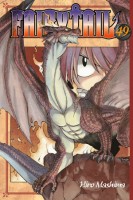 Fairy Tail, Volume 49 by Hiro Mashima. The forty-ninth volume of Fairy Tail brings to an end the Tartaros story arc while beginning new one. Since Igneel dominates the cover, I was hoping for an epic showdown between dragons. There is a pretty good fight, but sadly it’s over fairly quickly. In fact, the whole Tartaros arc seemed to be wrapped up sooner than anticipated. And indeed, Mashima mentions in the afterword that it was cut short. Even so, it ends in a suitably dramatic fashion and the next arc promises to be very interesting. Of course, Mashima does have to retcon a few things to really pull it off well. That’s one of the things about Fairy Tail that I’m consistently frustrated by—although Mashima claims to have thought out the story well in advance, due to the lack of adequate foreshadowing and what seems like constant rewriting, I’m not convinced. And as the series continues to grow in length (I don’t see Fairy Tail ending any time soon), keeping internal consistency is going to become more and more of a challenge. Even though magic is obviously a major part of Fairy Tail, I think it’s been used one to many times to backtrack the narrative when Mashima has written himself into a corner; major plot and character developments lose their impact if they can so easily be waved away later on.
Fairy Tail, Volume 49 by Hiro Mashima. The forty-ninth volume of Fairy Tail brings to an end the Tartaros story arc while beginning new one. Since Igneel dominates the cover, I was hoping for an epic showdown between dragons. There is a pretty good fight, but sadly it’s over fairly quickly. In fact, the whole Tartaros arc seemed to be wrapped up sooner than anticipated. And indeed, Mashima mentions in the afterword that it was cut short. Even so, it ends in a suitably dramatic fashion and the next arc promises to be very interesting. Of course, Mashima does have to retcon a few things to really pull it off well. That’s one of the things about Fairy Tail that I’m consistently frustrated by—although Mashima claims to have thought out the story well in advance, due to the lack of adequate foreshadowing and what seems like constant rewriting, I’m not convinced. And as the series continues to grow in length (I don’t see Fairy Tail ending any time soon), keeping internal consistency is going to become more and more of a challenge. Even though magic is obviously a major part of Fairy Tail, I think it’s been used one to many times to backtrack the narrative when Mashima has written himself into a corner; major plot and character developments lose their impact if they can so easily be waved away later on.
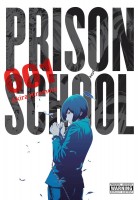 Prison School, Omnibus 1 by Akira Hiramoto. Some people, like me, may be familiar with Hiramoto as the creator of the acclaimed manga series Me and the Devil Blues, a supernaturally-tinged historical drama about a blues musician. Prison School is a completely different manga that, except for Hiramoto’s tremendous skill as an artist, has very little in common that earlier series. Prison School is an absurdly dramatic and over-the-top comedy. Even though the manga can hardly be taken seriously it will still likely be incredibly offensive and obscene to a large number of readers since the most powerful characters—the young women of Hachimitsu Private Academy’s shadow student council—are also the most sexualized and fetishized. The men in the series are all varying degrees of despicable, and they unapologetically revel in it. And yet, if one can stand the stunningly less-than-flattering portrayal of just about every character in the series, Prison School can be immensely entertaining and engaging. Considering all of the perversion, sadomasochism, nudity, and violence in Prison School, it’s certainly not a series that I would recommend to everyone, though. I expect that Prison School will be a divisive series, but I’m still intensely curious to see how the manga plays out.
Prison School, Omnibus 1 by Akira Hiramoto. Some people, like me, may be familiar with Hiramoto as the creator of the acclaimed manga series Me and the Devil Blues, a supernaturally-tinged historical drama about a blues musician. Prison School is a completely different manga that, except for Hiramoto’s tremendous skill as an artist, has very little in common that earlier series. Prison School is an absurdly dramatic and over-the-top comedy. Even though the manga can hardly be taken seriously it will still likely be incredibly offensive and obscene to a large number of readers since the most powerful characters—the young women of Hachimitsu Private Academy’s shadow student council—are also the most sexualized and fetishized. The men in the series are all varying degrees of despicable, and they unapologetically revel in it. And yet, if one can stand the stunningly less-than-flattering portrayal of just about every character in the series, Prison School can be immensely entertaining and engaging. Considering all of the perversion, sadomasochism, nudity, and violence in Prison School, it’s certainly not a series that I would recommend to everyone, though. I expect that Prison School will be a divisive series, but I’m still intensely curious to see how the manga plays out.

